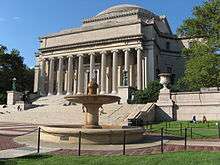SV Mandalay
The sailing vessel Mandalay is a three-masted schooner measuring 202 ft (62 m) at the waterline, with an almost indestructible Danish wrought iron hull. It was built as the private yacht Hussar (IV), and would later become the research vessel Vema, one of the world's most productive oceanographic research vessels. The ship currently sails as the cruising yacht Mandalay in the Caribbean.[2]
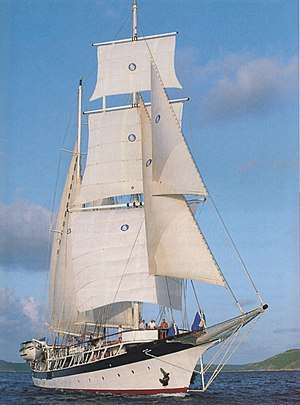 | |
| History | |
|---|---|
| Name: |
|
| Owner: |
|
| Operator: | 1953 - 81: Lamont-Doherty Earth Observatory[1] |
| Builder: | Burmeister & Wain, Copenhagen, Denmark[2] |
| Launched: | February 2, 1923[2] |
| Completed: | March 1923, rebuilt 1942 (USN), 1952 (Louis Kenedy, NS Canada), 196? (Lamont Geological Observatory), 1981 (Mike Burke, Windjammer Barefoot Cruises), 2010 (Angermeyer Cruises, Ecuador) |
| Identification: |
|
| Fate: | presently operated by Sail Windjammer, https://sailwindjammer.com/ |
| General characteristics | |
| Type: | schooner |
| Tonnage: | 585 GRT[2] |
| Length: | 49.9 m (163 ft 9 in) (pp)[2] |
| Beam: | 10.1 m (33 ft 2 in)[2] |
| Depth: | 15 m (49 ft 3 in)[3] |
| Decks: | three |
| Propulsion: | 900 BHP V12 GM diesel circa 1942 |
| Speed: | 16 knots under full sail |
| Capacity: | 72 passengers (as Mandalay)[3] |
| Crew: | about 28 (as Mandalay)[3] |
E.F. Hutton's luxury yacht, Hussar IV
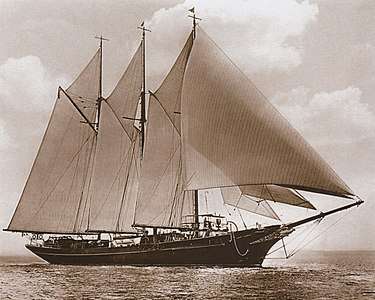
Designed by Cox & Stevens and built in 1923 by Burmeister & Wain[4] in Copenhagen for E. F. Hutton and his wife Marjorie Merriweather Post, the 585-ton luxury yacht Hussar (IV), had an iron-hull and represented the epitome of maritime luxury and glamour in her class.[1][5] Interiors were designed by William Baumgarten & Co of New York, and was the first American firm to do the interior decoration of a ship abroad.[6] Upon her completion in Denmark, King Christian X of Denmark was invited to inspect the ship prior to its maiden crossing to New York.[6] It was one of the fastest yachts, breaking the transatlantic record in 10 days, 21 hours. The yacht was affiliated with the New York Yacht Club,[7]and spent the winters in the Florida Keys with frequent guests Billie Burke, along with Florenz Ziegfeld who Hutton liked to deep sea fish with.[8]
 Parlor circa 1923
Parlor circa 1923 Dining Room circa 1923
Dining Room circa 1923 Deck plan circa 1923
Deck plan circa 1923 Profile of Hussar IV
Profile of Hussar IV
Norwegian yacht, Vema
In the late 1920s the Hutton's decided they wanted a larger yacht, so they commissioned the construction of the Hussar (V) (later Sea Cloud). The Hussar IV was put up for sale in September 1930[9], and eventually sold to Norwegian shipping magnate, G. Unger Vetlesen and his wife Maude Monell and renamed Vema, a combination of Vetlesen and Maude. The Vetlesens spent many pleasurable days at sea.
U.S. WWII Service
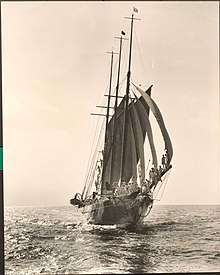
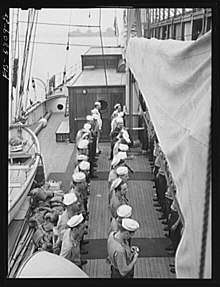
During World War II, Maude Monell donated Vema to the American war effort. The vessel was put into service as a merchant marine cadet training ship.[11] The Vema was first put to use patrolling coastal waters for the US Coast Guard.[1] She served as a barrack and a training ship for the United States Merchant Marine. Assigned to the US Maritime Service Training Station on Hoffman Island, her sailing area was listed as 14,000 sqf.[12] After the war she was abandoned off Staten Island until Louis Kenedy, a captain from Nova Scotia, salvaged the vessel.[1][13] LDEO leased the vessel in 1953 and soon bought her for $100,000.[1]
Research Vessel Vema
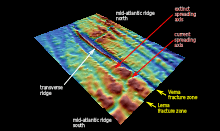
Vema started circling the globe as the first of the Lamont Geological Observatory research vessels (now the Lamont-Doherty Earth Observatory [LDEO]), a research unit of Columbia University.. Displaying a black hull, she was used to collect samples of seawater and sediment cores, measure currents and heat flows, perform underwater photography and seismic studies, and map out ocean floors. The work on the ship helped to confirm the continental drift theory. By the time of her retirement in 1981, the Vema had collected data on a record track of 1,225,000 nautical miles (2,269,000 km).[1] Notable scientists who worked aboard the Vema include Maurice Ewing, Bruce C. Heezen, Ralph (Ralphy) Roessler, J. Lamar Worzel,[14] Jack Nafe, Frank Press, and Walter Pitman, all of whose work was greatly facilitated by Marine Technical Coordinator Robert Gerard, who was responsible for the fitting and refitting of LDEO marine research vessels from the Vema through her successors, the Conrad, Eltanin, and RV Maurice Ewing, including the design and installation of numerous pieces of customized scientific measurement equipment critical to their research.
Seafloor features
- The Vema was instrumental in the exploration of the Mid-Atlantic Ridge.[15] The Vema Fracture Zone, crossing the Mid-Atlantic Ridge at 10.726°N 42.333°W, was named for her. G.R. Hamilton aboard RV Vema discovered this feature in 1956.[16]
- Vema Trench in the Indian Ocean is in fact a fracture zone named trench to avoid confusion with the Vema Fracture Zone in the Atlantic Ocean mentioned above. Vema Trench crosses the Central Indian Ridge at 8.98°S 67.57°E. RV Vema discovered it in 1958.[17]
- During the seafloor explorations the Vema Seamount was discovered in 1959; the seamount rises from a depth of almost 5,000 meters to just 11 meters below sea level, and is located in the South Atlantic about 1,000 km west-north-west of Cape Town, at 31°38′S 8°20′E.[18]
- Vema Knoll at 23°40′N 66°58′W and Vema Gap at 23°30′N 67°00′W are located adjacent to each other, 500 km north of Puerto Rico.[17]
- The Vema Channel is a deep trough in the Rio Grande Rise of the South Atlantic at 31.3°S 39.4°W. Discovered during one of Vema's journeys, it has a depth of 4,646 m and a width of 18 km, serving as a conduit for the Antarctic Bottom Water and Weddell Sea bottom water.[19]
Other research vessels of the LDEO
- USNS Robert D. Conrad, 1962–1989
- USNS Eltanin, 1962–1974
- RV Maurice Ewing, 1988–2005
- RV Marcus G. Langseth, 2004-[1]
Cruising yacht Mandalay
The ship was refitted again as a cruising yacht for the Caribbean under the name SV Mandalay (also Mandalay of Tortola)[2] with a sail area of > 20,000 square feet (1,900 m2).[3] The ship was operated by Windjammer Barefoot Cruises from 1982 until the operator went out of business in 2008.[20] Mandalay subsequently was purchased at auction, refurbished, and used as specialty cruise ship in the Galapagos islands off Ecuador by Angermeyer Cruises. The S/V Mandalay is currently scheduled through Sail Windjammer, Inc. She sails weekly out of Grenada for one and two-week cruises in the Grenadines.[21]
External links
References
- Lamont-Doherty Earth Observatory. "Marine Operations: Vema (1953-1981)". Retrieved January 31, 2009.
- "Mandalay (7738383)". Miramar Ship Index. Retrieved 8 May 2020.
- Mandalay information
- Pacific Marine Review. J.S. Hines. 1924.
- Arts & Decoration. A. Budge. 1923.
- Barton, Amos (September 1923). "Interior Decoration on the High Seas". Arts & Decoration: 328.
- MacKay, Robert B. (2014-06-09). Great Yachts of Long Island's North Shore. Arcadia Publishing. ISBN 978-1-4396-4566-6.
- Rubin, Nancy (2004-01-04). American Empress: The Life and Times of Marjorie Merriweather Post. iUniverse. ISBN 978-0-595-75202-7.
- "E.F. Huttons to Sell Yacht". timesmachine.nytimes.com. Retrieved 2020-05-24.
- "Hoffmann Island, merchant marine training center off Staten Island, New York. Trainees aboard the schooner Vema". Library of Congress, Washington, D.C. 20540 USA. Retrieved 2020-05-16.
- U.S. Coast Guard Bulletin. Coast Guard. 1939.
- Hoffman Island access date February 3, 2009
- Wertenbaker, William (1974). The Floor of the Sea: Maurice Ewing and the Search to Understand the Earth. Boston: Little, Brown and Company.
- Worzel, J. Lamar (1959). "Extensive deep sea sub-bottom reflections identified as white ash". Proc Natl Acad Sci U S A. 45 (3): 349–355. Bibcode:1959PNAS...45..349W. doi:10.1073/pnas.45.3.349. PMC 222564. PMID 16590389.
- Vema (Library Association of Rockland) County
- Heezen, B. C.; Gerard, R. D.; Tharp, M. (1964). "The Vema Fracture Zone in the Equatorial Atlantic". Journal of Geophysical Research. 69 (4): 733. Bibcode:1964JGR....69..733H. doi:10.1029/JZ069i004p00733.
- "IHO-IOC GEBCO Gazetteer of Undersea Feature Names, March 2011 version; www.gebco.net". GEBCO. Archived from the original on 2012-04-21. Retrieved 2011-11-16.
- Antarctic: Flying fish at the Vema seamount. Archived 2012-08-02 at Archive.today accessdate=february 2, 2009
- AMS glossary accessdate=February 2, 2009
- Windjammer Cruises Officially Out of Business, April 2, 2008
- "Sail Windjammer". Sail Windjammer. Retrieved 2020-05-06.
